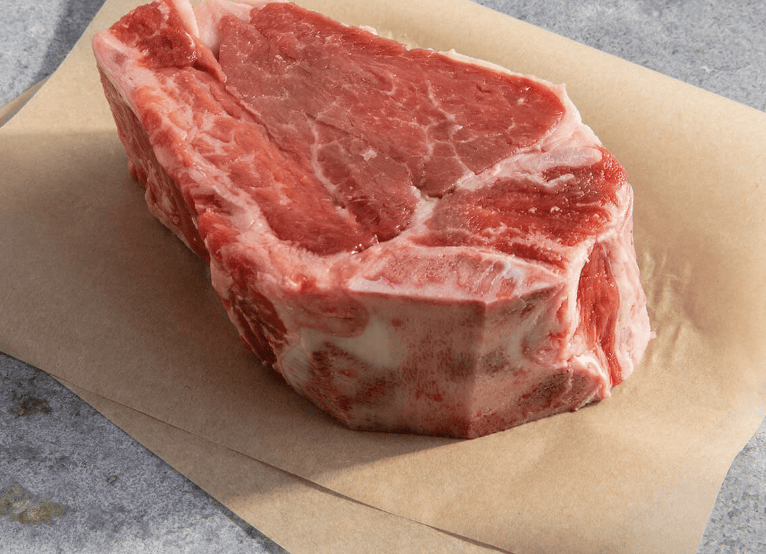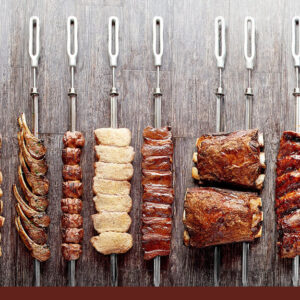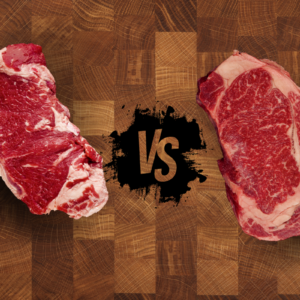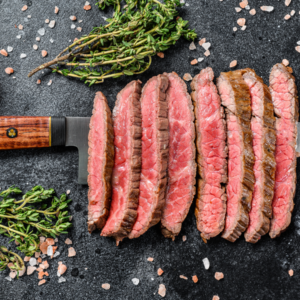Bone In Filet Mignon On The Grill

Filet mignon has earned a reputation among carnivores as one of the tenderest cuts of beef. The words “buttery” and “melt-in-your mouth” often coincide with a bite of perfectly cooked mignon. If you can believe it, bone in filet mignon is even more tender than its boneless counterpart. Today, we’ll teach you how to grill a bone-in filet mignon that is so juicy, you’ll wonder why you ever had it any other way.
Table of Contents
Where Does Bone In Filet Mignon Come From?
Boneless filet mignon comes from the smaller end of the cow’s tenderloin, which is the psoas muscle. There are two of these muscles that run along either side of the cow’s backbone. Bone in filet mignon is larger than boneless, and it comes from the middle of the loin rather than the smaller end. It is butchered with the rib bone intact and protruding slightly from one side.
The name is French for “cute filet,” likely a reference to the delicate portion and round shape of the filet mignon. Ironically, the French themselves do not call this cut of beef “filet mignon.” This term actually applies to pork in France and other European countries. What we call filet mignon is more commonly known as “filet de boeuf” or “filet steak.”
Benefits of Bone In Filet Mignon vs. Bone-Out
As most meat aficionados will tell you, bones mean flavor and succulence. The bone acts as a natural insulator during cooking, helping the meat retain moisture and cook evenly. Furthermore, the cartilage and marrow within the bone seep into the meat, giving it an unctuous texture.
If the flavor and tenderness aren’t enough to convince you, the bone-in filet mignon is also unparalleled when it comes to presentation. It is a rare cut of beef, so having one of these as the star of your next cookout will definitely earn you coolness points.
Is Bone-In Filet Mignon Lean?
Yes. Bone-in filet mignon is still considered a leaner cut of beef. However, you’ll notice more pockets of marbling compared to the boneless mignon, which is uniformly red and mostly free of connective tissue.
Bone-in filet mignon is also nutrient dense, being an excellent source of iron, protein, vitamin B12, and calcium. Of course, beef, in general, is higher in calories than other types of protein. Diet-conscious eaters will want to stick to smaller portions or opt for leaner meats, like poultry, lamb, or fish. For reference, a 3.5 oz serving of bone-in filet mignon adds up to around 270 calories.
Should You Marinate Bone-In Filet Mignon?
You can, but it is not necessary. Marinades can lend flavor but also act predominantly to tenderize the meat. Bone-in filet mignons are already naturally tender, so all they need is light seasoning and a quick cooking method (see below). If you want to kick up the flavor, we recommend topping the finished steak with a generous pat of herbed butter. Try the following:
- 8 oz softened butter
- 1 clove minced garlic
- ½ tsp minced fresh thyme
- ½ tsp minced fresh rosemary
- ½ tsp sea salt
Mix all the ingredients together in a bowl, then transfer to a length of cling film or wax paper. Shape the butter into a log, and roll it up tight in the wrapper. Refrigerate it for two hours, then slice onto your steak when needed.
Tips for Cooking Filet Mignon
Regardless of the method you choose, there are a few key steps when it comes to preparing a perfect bone-in filet mignon:
Doneness Level: Due to its delicate nature ,bone-in filet mignon is best served medium-rare to (135 degrees Fahrenheit) preserve its tenderness and subtle beefy flavor.
Preparation: allow the steak to come to room temperature before cooking to ensure even cooking throughout.
Cooking Temperature: tender cuts of beef do best at high temperatures and quick cooking times. Sear the filet mignon over high heat to develop a flavorful crust, then finish cooking to the desired doneness on indirect heat.
Resting Time: let your bone in filet mignon rest for at least the steak to rest for at least five minutes per inch, or ten minutes per pound.
Grilling Bone-In Filet Mignon
Grilling filet mignon infuses it with a delightful smokiness while preserving its inherent tenderness. In our opinion, it is the best possible way to prepare this cut of beef. Here’s how to grill the perfect bone-in filet mignon:
Prepare the Grill
Clean and oil the grates of your grill to ensure an even, beautiful sear and avoid unwanted flavors from burned-on bits.
Preheat the Grill
Preheat one side of your gas grill for high heat. On coals, build your fire off to one side, leaving the other side free for indirect cooking. Ensure your grill is fully preheated before you start cooking the steak.
Season the Bone In Filet Mignon
Season the steaks on both sides with plenty of salt and freshly ground black pepper. For a 1 lb steak, you’ll want at least 3/4 tsp of salt.
Grill on High Heat
Place the bone in filet mignon on the grill over direct heat and sear for 2-3 minutes on each side to form a good crust. Then, move it to indirect heat and continue grilling until your thermometer reads 130-135 degrees fahrenheit.
Rest the Steak
Transfer your bone-in filet mignon to a plate and let it rest for ten minutes. Slice across the grain and serve with a pat of herbed butter.
Where to Buy Bone In Filet Mignon?
Again, bone-in filet mignons are not easy to come by. Aside from specialty butcher shops, you won’t come across these in person in most stores. Luckily, they are readily available online in Texas de Brazil’s butcher shop: 16 oz of prime, center cut USDA Choice angus delivered right to your door in time for your next cookout. Check out our other offerings as well, from Australian rack of lamb to our world-famous picanha.




